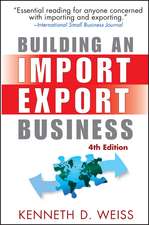The Gravity Model in International Trade: Advances and Applications
Editat de Peter A. G. van Bergeijk, Steven Brakmanen Limba Engleză Paperback – 29 oct 2014
| Toate formatele și edițiile | Preț | Express |
|---|---|---|
| Paperback (1) | 421.48 lei 6-8 săpt. | |
| Cambridge University Press – 29 oct 2014 | 421.48 lei 6-8 săpt. | |
| Hardback (1) | 785.82 lei 6-8 săpt. | |
| Cambridge University Press – 9 iun 2010 | 785.82 lei 6-8 săpt. |
Preț: 421.48 lei
Nou
Puncte Express: 632
Preț estimativ în valută:
80.65€ • 84.20$ • 66.75£
80.65€ • 84.20$ • 66.75£
Carte tipărită la comandă
Livrare economică 04-18 aprilie
Preluare comenzi: 021 569.72.76
Specificații
ISBN-13: 9781107454514
ISBN-10: 1107454514
Pagini: 374
Ilustrații: 26 b/w illus. 66 tables
Dimensiuni: 152 x 229 x 20 mm
Greutate: 0.5 kg
Editura: Cambridge University Press
Colecția Cambridge University Press
Locul publicării:New York, United States
ISBN-10: 1107454514
Pagini: 374
Ilustrații: 26 b/w illus. 66 tables
Dimensiuni: 152 x 229 x 20 mm
Greutate: 0.5 kg
Editura: Cambridge University Press
Colecția Cambridge University Press
Locul publicării:New York, United States
Cuprins
List of figures; List of tables; 1. Introduction: the comeback of the gravity equation S. Brakman and P. A. G. van Bergeijk; Part I. Methodology: 2. A general equilibrium theory for estimating gravity equations of bilateral FDI, final goods, and intermediate trade flows J. H. Bergstrand and P. Egger; 3. The incidence of gravity J. E. Anderson; 4. Approximating general equilibrium impacts of trade liberalizations using the gravity equation: applications to NAFTA and the European Economic Area S. L. Baier and J. H. Bergstrand; 5. An extended gravity model with substitution applied to international trade J. A. Bikker; Part II. Distance in the Gravity Model: 6. Illusory border effects: distance mismeasurement inflates estimates of home bias in trade K. Head and T. Mayer; 7. Trade costs, market access and economic geography: why the empirical specification of trade costs matters M. Bosker and H. Garretsen; 8. Intangible barriers to international trade: a sectoral approach J. Möhlmann, S. Ederveen, H. L. F. de Groot and G.-J. M. Linders; Part III. Specific Applications: 9. International environmental arrangements and international commerce A. Rose and M. Spiegel; 10. Diplomatic relations and trade reorientation in transition countries E. Afman and M. Maurel; 11. Unlocking the value of cross-border mergers and acquisitions S. Brakman, H. Garretsen, G. Garita and C. van Marrewijk; 12. The impact of economic geography on GDP per capita in OECD countries H. Boulhol and A. de Serres; Index.
Recenzii
'Theoretical foundations and empirical estimation strategy of gravity models have significantly advanced over the last years. By tracing the history of this evolution and offering a rich sample of applications, this book will prove to be a very useful reference to both those new to the field and those in search of an up-to-date treatment of theoretical and methodological issues related to gravity models.' Roberta Piermartini, World Trade Organisation
Descriere
This book explains the history of the gravity model of international trade and takes stock of recent methodological and theoretical advances.


















